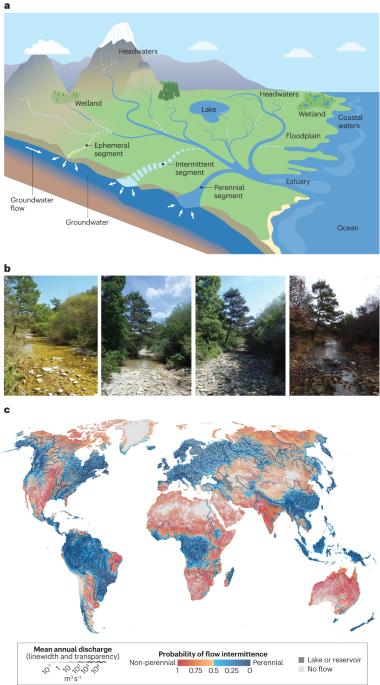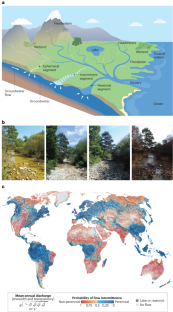Non-perennial segments in river networks
引用次数: 0
Abstract
Non-perennial river segments — those that recurrently cease to flow or frequently dry — occur in all river networks and are globally more abundant than perennial (always flowing) segments. However, research and management have historically focused on perennial river segments. In this Review, we outline how non-perennial segments are integral parts of river networks. Repeated cycles of flowing, non-flowing and dry phases in non-perennial segments influence biodiversity and ecosystem dynamics at different spatial scales, from individual segments to entire river networks. Varying configurations of perennial and non-perennial segments govern physical, chemical and ecological responses to changes in the flow regimes of each river network, especially in response to human activities. The extent of non-perennial segments in river networks has increased owing to warming, changing hydrological patterns and human activities, and this increase is predicted to continue. Moreover, the dry phases of flow regimes are expected to be longer, drier and more frequent, albeit with high regional variability. These changes will likely impact biodiversity, potentially tipping some ecosystems to compromised stable states. Effective river-network management must recognize ecosystem services (such as flood risk management and groundwater recharge) provided by non-perennial segments and ensure their legislative and regulatory protection, which is often lacking. Non-perennial segments of rivers undergo cycles of flowing, non-flowing and dry phases, influencing ecosystem dynamics and services across the river network. This Review describes the occurrence, ecology and future of these intermittent and ephemeral flows and highlights the importance of protecting these segments.


河网中的非多年生河段
非多年生河段——那些经常停止流动或经常干涸的河段——出现在所有河网中,在全球范围内比多年生(总是流动的)河段更丰富。然而,研究和管理历来集中在多年生河段上。在这篇综述中,我们概述了非多年生河段如何成为河网的组成部分。从单个河段到整个河网,非多年生河段的流动、非流动和干燥阶段的反复循环影响着不同空间尺度上的生物多样性和生态系统动态。多年生河段和非多年生河段的不同配置决定了对每个河网流量变化的物理、化学和生态反应,特别是对人类活动的反应。由于气候变暖、水文模式变化和人类活动,河网中非多年生河段的范围有所增加,预计这种增加将继续下去。此外,尽管区域差异很大,但预计流态的干燥阶段将更长、更干燥和更频繁。这些变化可能会影响生物多样性,可能会使一些生态系统陷入受损的稳定状态。有效的河网管理必须认识到非多年生河段提供的生态系统服务(如洪水风险管理和地下水补给),并确保它们的立法和监管保护,而这些保护往往是缺乏的。
本文章由计算机程序翻译,如有差异,请以英文原文为准。
求助全文
约1分钟内获得全文
求助全文

 求助内容:
求助内容: 应助结果提醒方式:
应助结果提醒方式:


